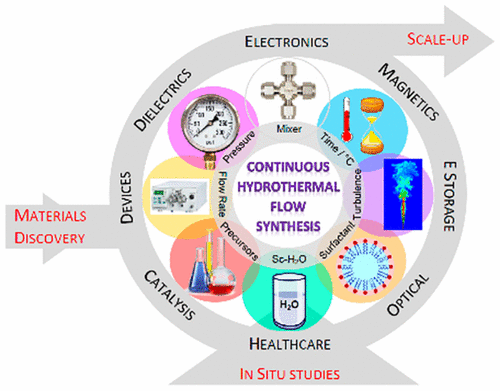当前位置:
X-MOL 学术
›
Chem. Rev.
›
论文详情
Our official English website, www.x-mol.net, welcomes your
feedback! (Note: you will need to create a separate account there.)
Continuous Hydrothermal Synthesis of Inorganic Nanoparticles: Applications and Future Directions
Chemical Reviews ( IF 51.4 ) Pub Date : 2017-08-03 00:00:00 , DOI: 10.1021/acs.chemrev.6b00417 Jawwad A. Darr 1 , Jingyi Zhang 2 , Neel M. Makwana 1 , Xiaole Weng 2
Chemical Reviews ( IF 51.4 ) Pub Date : 2017-08-03 00:00:00 , DOI: 10.1021/acs.chemrev.6b00417 Jawwad A. Darr 1 , Jingyi Zhang 2 , Neel M. Makwana 1 , Xiaole Weng 2
Affiliation

|
Nanomaterials are at the leading edge of the emerging field of nanotechnology. Their unique and tunable size-dependent properties (in the range 1–100 nm) make these materials indispensable in many modern technological applications. In this Review, we summarize the state-of-art in the manufacture and applications of inorganic nanoparticles made using continuous hydrothermal flow synthesis (CHFS) processes. First, we introduce ideal requirements of any flow process for nanoceramics production, outline different approaches to CHFS, and introduce the pertinent properties of supercritical water and issues around mixing in flow, to generate nanoparticles. This Review then gives comprehensive coverage of the current application space for CHFS-made nanomaterials including optical, healthcare, electronics (including sensors, information, and communication technologies), catalysis, devices (including energy harvesting/conversion/fuels), and energy storage applications. Thereafter, topics of precursor chemistry and products, as well as materials or structures, are discussed (surface-functionalized hybrids, nanocomposites, nanograined coatings and monoliths, and metal–organic frameworks). Later, this Review focuses on some of the key apparatus innovations in the field, such as in situ flow/rapid heating systems (to investigate kinetics and mechanisms), approaches to high throughput flow syntheses (for nanomaterials discovery), as well as recent developments in scale-up of hydrothermal flow processes. Finally, this Review covers environmental considerations, future directions and capabilities, along with the conclusions and outlook.
中文翻译:

连续水热合成无机纳米粒子的应用及未来方向
纳米材料处于纳米技术新兴领域的前沿。它们独特且可调的尺寸依赖性(在1–100 nm范围内)使这些材料在许多现代技术应用中必不可少。在这篇综述中,我们总结了使用连续水热流合成(CHFS)工艺制造的无机纳米颗粒的制造和应用领域的最新技术。首先,我们介绍了纳米陶瓷生产的任何流动过程的理想要求,概述了CHFS的不同方法,并介绍了超临界水的相关特性以及围绕流动混合产生纳米颗粒的问题。然后,本综述全面介绍了CHFS制纳米材料的当前应用空间,包括光学,医疗保健,电子(包括传感器,信息,和通讯技术),催化,设备(包括能量收集/转化/燃料)和能量存储应用。此后,讨论了前体化学和产品以及材料或结构的主题(表面功能化的杂化物,纳米复合材料,纳米颗粒状涂层和整料以及金属有机框架)。后来,本文将重点介绍该领域的一些关键设备创新,例如原位流/快速加热系统(以研究动力学和机理),高通量流合成方法(用于纳米材料的发现)以及最新进展。在扩大热液流过程中。最后,本综述涵盖了环境方面的考虑,未来的方向和能力以及结论和展望。设备(包括能量收集/转换/燃料)以及能量存储应用。此后,讨论了前体化学和产品以及材料或结构的主题(表面功能化的杂化物,纳米复合材料,纳米颗粒状涂层和整料以及金属有机框架)。后来,本文将重点介绍该领域的一些关键设备创新,例如原位流/快速加热系统(以研究动力学和机理),高通量流合成方法(用于纳米材料发现)以及最新进展。在扩大热液流过程中。最后,本综述涵盖了环境方面的考虑,未来的方向和能力以及结论和展望。设备(包括能量收集/转换/燃料)以及能量存储应用。此后,讨论了前体化学和产品以及材料或结构的主题(表面功能化的杂化物,纳米复合材料,纳米颗粒状涂层和整料以及金属有机框架)。后来,本文将重点介绍该领域的一些关键设备创新,例如原位流/快速加热系统(以研究动力学和机理),高通量流合成方法(用于纳米材料的发现)以及最新进展。在扩大热液流过程中。最后,本综述涵盖了环境方面的考虑,未来的方向和能力以及结论和展望。讨论了前体化学和产品以及材料或结构的主题(表面功能化的杂化物,纳米复合材料,纳米颗粒状涂层和整料以及金属有机框架)。后来,本文将重点介绍该领域的一些关键设备创新,例如原位流/快速加热系统(以研究动力学和机理),高通量流合成方法(用于纳米材料的发现)以及最新进展。在扩大热液流过程中。最后,本综述涵盖了环境方面的考虑,未来的方向和能力以及结论和展望。讨论了前体化学和产品以及材料或结构的主题(表面功能化的杂化物,纳米复合材料,纳米颗粒状涂层和整料以及金属有机框架)。后来,本文将重点介绍该领域的一些关键设备创新,例如原位流/快速加热系统(以研究动力学和机理),高通量流合成方法(用于纳米材料发现)以及最新进展。在扩大热液流过程中。最后,本综述涵盖了环境方面的考虑,未来的方向和能力以及结论和展望。本文将重点介绍该领域的一些关键设备创新,例如原位流/快速加热系统(以研究动力学和机理),高通量流合成方法(用于纳米材料的发现)以及规模的最新发展热流过程的特写。最后,本综述涵盖了环境方面的考虑,未来的方向和能力以及结论和展望。本文将重点介绍该领域的一些关键设备创新,例如原位流/快速加热系统(以研究动力学和机理),高通量流合成方法(用于纳米材料的发现)以及规模的最新发展热流过程的特写。最后,本综述涵盖了环境方面的考虑,未来的方向和能力以及结论和展望。
更新日期:2017-08-03
中文翻译:

连续水热合成无机纳米粒子的应用及未来方向
纳米材料处于纳米技术新兴领域的前沿。它们独特且可调的尺寸依赖性(在1–100 nm范围内)使这些材料在许多现代技术应用中必不可少。在这篇综述中,我们总结了使用连续水热流合成(CHFS)工艺制造的无机纳米颗粒的制造和应用领域的最新技术。首先,我们介绍了纳米陶瓷生产的任何流动过程的理想要求,概述了CHFS的不同方法,并介绍了超临界水的相关特性以及围绕流动混合产生纳米颗粒的问题。然后,本综述全面介绍了CHFS制纳米材料的当前应用空间,包括光学,医疗保健,电子(包括传感器,信息,和通讯技术),催化,设备(包括能量收集/转化/燃料)和能量存储应用。此后,讨论了前体化学和产品以及材料或结构的主题(表面功能化的杂化物,纳米复合材料,纳米颗粒状涂层和整料以及金属有机框架)。后来,本文将重点介绍该领域的一些关键设备创新,例如原位流/快速加热系统(以研究动力学和机理),高通量流合成方法(用于纳米材料的发现)以及最新进展。在扩大热液流过程中。最后,本综述涵盖了环境方面的考虑,未来的方向和能力以及结论和展望。设备(包括能量收集/转换/燃料)以及能量存储应用。此后,讨论了前体化学和产品以及材料或结构的主题(表面功能化的杂化物,纳米复合材料,纳米颗粒状涂层和整料以及金属有机框架)。后来,本文将重点介绍该领域的一些关键设备创新,例如原位流/快速加热系统(以研究动力学和机理),高通量流合成方法(用于纳米材料发现)以及最新进展。在扩大热液流过程中。最后,本综述涵盖了环境方面的考虑,未来的方向和能力以及结论和展望。设备(包括能量收集/转换/燃料)以及能量存储应用。此后,讨论了前体化学和产品以及材料或结构的主题(表面功能化的杂化物,纳米复合材料,纳米颗粒状涂层和整料以及金属有机框架)。后来,本文将重点介绍该领域的一些关键设备创新,例如原位流/快速加热系统(以研究动力学和机理),高通量流合成方法(用于纳米材料的发现)以及最新进展。在扩大热液流过程中。最后,本综述涵盖了环境方面的考虑,未来的方向和能力以及结论和展望。讨论了前体化学和产品以及材料或结构的主题(表面功能化的杂化物,纳米复合材料,纳米颗粒状涂层和整料以及金属有机框架)。后来,本文将重点介绍该领域的一些关键设备创新,例如原位流/快速加热系统(以研究动力学和机理),高通量流合成方法(用于纳米材料的发现)以及最新进展。在扩大热液流过程中。最后,本综述涵盖了环境方面的考虑,未来的方向和能力以及结论和展望。讨论了前体化学和产品以及材料或结构的主题(表面功能化的杂化物,纳米复合材料,纳米颗粒状涂层和整料以及金属有机框架)。后来,本文将重点介绍该领域的一些关键设备创新,例如原位流/快速加热系统(以研究动力学和机理),高通量流合成方法(用于纳米材料发现)以及最新进展。在扩大热液流过程中。最后,本综述涵盖了环境方面的考虑,未来的方向和能力以及结论和展望。本文将重点介绍该领域的一些关键设备创新,例如原位流/快速加热系统(以研究动力学和机理),高通量流合成方法(用于纳米材料的发现)以及规模的最新发展热流过程的特写。最后,本综述涵盖了环境方面的考虑,未来的方向和能力以及结论和展望。本文将重点介绍该领域的一些关键设备创新,例如原位流/快速加热系统(以研究动力学和机理),高通量流合成方法(用于纳米材料的发现)以及规模的最新发展热流过程的特写。最后,本综述涵盖了环境方面的考虑,未来的方向和能力以及结论和展望。











































 京公网安备 11010802027423号
京公网安备 11010802027423号